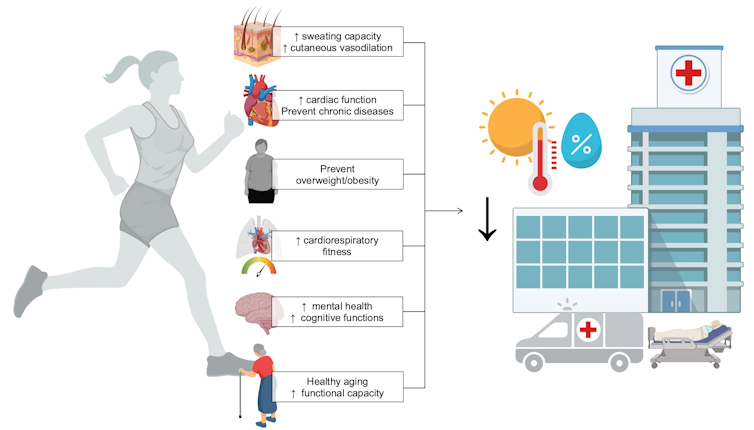
Climate change, a high prevalence of chronic diseases and alarming levels of physical inactivity are three of the central challenges we face in the 21st century.
The increased frequency, duration and intensity of heat waves is one of the undeniable signs that climate change is well underway. According to the various climate scenarios, by the end of the century between half and three-quarters of the world’s population will be exposed to lethal heat for more than 20 days per year.
The future impact of extreme heat events will depend on the extent of climate change, but also on our ability to adapt to it by becoming less sensitive and vulnerable to heat, and therefore more resilient. As researchers in physical activity science and environmental physiology, we are assessing how adopting an active lifestyle can make us better equipped to cope with rising global temperatures.
How can the human body combat heat?

When exposed to heat, the body deploys several responses to try to dissipate it. The first is conscious and depends on behavioural decisions we make to minimize exposure, such as seeking a cool place, switching on a fan or reducing our physical activity.
Secondly, if these strategies are not sufficient, the brain activates physiological responses that are beyond our control; blood vessels in the skin dilate to increase the blood supply and sweat glands increase their activity to excrete more sweat.
So it’s not surprising that any factor that affects these responses can alter the body’s ability to react adequately to heat exposure.
Who are the most vulnerable groups?
Although heat affects us all, evidence shows that certain groups of people are more sensitive to it, which increases their vulnerability.
A number of individual factors including age, pre-existing health problems such as cardiovascular disease and Type 2 diabetes, the use of certain medications (anticholinergic drugs, beta blockers, antidepressants and diuretics, among others), being overweight or obese, having low functional and cognitive abilities and low cardiorespiratory fitness are all associated with reduced heat tolerance and a greater risk of developing heat-related health problems. This is reflected in public health figures since these factors are associated with an increased risk of hospitalization or death during an extreme heat event.
This finding can be explained by the fact that several of these conditions are associated with two physiological responses:
reduced voluntary and autonomous heat dissipation capacities, which increase the stress imposed on the body;
reduced physiological potential, which reduces the body’s ability to cope.
Together, these two conditions increase the likelihood that the stress placed on the body will reach and exceed the body’s physiological potential, increasing the risk of developing heat-related health problems.
How can regular physical activity improve resilience to heat?

Interestingly, of the many risk factors for developing heat-related health problems, several can be avoided by adopting a healthy, active lifestyle. In fact, doing regular physical activity throughout one’s life could mean being better equipped to cope with rising global temperatures:
By bringing about a number of physiological adaptations that increase heat dissipation capacity (increased sweat production) and the body’s physiological potential (increased cardiovascular reserve), thereby increasing heat tolerance and helping to meet the increased demands placed on the cardiovascular system during heat stress;
By limiting the decline in cardiorespiratory fitness and thermoregulatory functions associated with obesity, chronic disease and the use of certain medications. Regular physical activity can also help to limit cognitive and functional decline, enabling people to maintain their independence, an important protective factor against heat;
By slowing the decline in cardiovascular function and thermoregulatory functions inherent in aging;
By contributing to improved mental well-being, which could help people cope with the stress associated with extreme heat episodes.
Physical activity could therefore make an important contribution to our ability to adapt to rising global temperatures, increasing our individual and community resilience.
However, it is important to note that a number of other risk factors are not directly modifiable by a healthy and active lifestyle, including certain mental health disorders, low socio-economic status and limited access to cool or air-conditioned places, among others. It is also well established that people who engage in intense to moderate physical activity during heat episodes are at greater risk of developing heat-related health problems (agricultural workers, construction workers, restaurant workers, etc.).
Is the next generation sufficiently equipped to meet this challenge?
In Canada, the prevalence of obesity among five- to 17-year-olds has almost tripled in the last 30 years. Currently, more than nine out of 10 young people do not meet Canada’s 24-hour exercise guidelines. The same is true worldwide.

In Québec, recent figures paint a picture that is more than alarming: a 15 per cent decrease in cardiorespiratory capacity and a 30 per cent decrease in functional capacity in young people compared with their elders who underwent the same tests in the 1980s. Worse still, the researchers observed that among 15- to 17-year-olds, six out of 10 boys and seven out of 10 girls have a cardiorespiratory capacity that will expose them to cardiometabolic health problems in the future.
Such trends suggest that today’s young people may be less and less equipped to tolerate heat, while they will be increasingly exposed to it. From a public health point of view, this is alarming. Maintaining regular physical activity and adequate fitness throughout their lives could make young people better equipped to meet these challenges.
The authors do not work for, consult, own shares in or receive funding from any company or organisation that would benefit from this article, and have disclosed no relevant affiliations beyond their academic appointment.
* This article was originally published at The Conversation

0 Comments